Feng-shui Definition
Feng-shui is composed of two words feng (wind) and shui (water) the two essentials for life or qi. In practical terms, feng-shui is the art of adapting buildings, rooms and furniture so as to achieve harmony with nature - in effect with the local environment and climate. There are two schools of thought:
- Jiang-xi school of earthly forms which focusses on forms of landscape
- Fu-jian school of cosmology which focusses on rational methods of decisions that impinge on ordinary life
The Ideal Feng-shui Site
"A site should be surrounded on three sides by higher land, like the crook of the elbow in a curved arm, to provide protection from inclement weather or an enemy. The lie of the land should be gently sloping and, if possible, there should be a river or valley nearby to allow surface water to drain easily."
The Burial Book (Zang-shu) trans. by Lawrence Liu (1989)
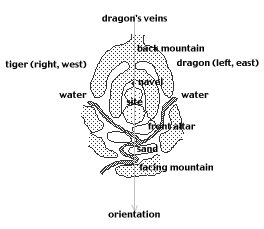
Cosmology
Form of geomancy was based on the principle of change according to the Yi-jing, eight-trigrams and five-stars, whereby general relationships of creation and destruction can be determined from which a variety of auspicious or inauspicious situations, measurements, special events etc. can be ascertained.
Principle of change
change |
 |
two principles |
 |
 |
four bigrams |
 |
 |
 |
 |
eight trigrams |
 |
 |
 |
 |
 |
 |
 |
 |
nature |
heaven |
lake |
son |
thunder |
wind |
moon |
mountain |
earth |
kinship |
father |
youngest daughter |
middle daughter |
eldest son |
eldest daughter |
middle son |
youngest son |
mother |
number |
9 |
4 |
3 |
8 |
2 |
7 |
6 |
1 |
value |
9 |
8 |
8 |
7 |
8 |
7 |
7 |
6 |
Former heaven order
The trigrams are arranged according to the above numbers in the magic square defined by He-tù and Luó-shu.
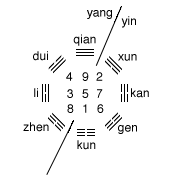
Later heaven order
The trigram values sum to 60 which can be divided into yin/yang groups with a sum of 30 each:
- qian, zhen, kan, gen
- dui, li, xun, kun
These are then paired in a unique way that maintains divisional balance.
7, 9 (qian) |
7, 7 |
8, 6 (kun) |
8, 8 |
Legend has it that the King Zhou gave his eldest son (zhen trigram) lands to the east. The middle son (kan) and daughter (li) are in opposing directions. The trigram dui is positioned to the west for reasons still unknown.
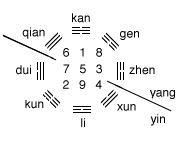
Five-stars (phases)
The five-stars is the other element of the cosmology theory and defines the rules for determining good fortune.
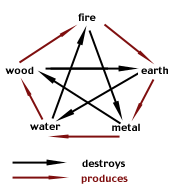
Chinese Calendar
"A calendar is only a method of combining days into periods suitable for civil life and religious or cultural observations. Some of its elements are based on those astronomical cycles which have obvious importance for man, such as the day, the month and the year; others are artificial, such as the week and the subdivisions of the day."
Joseph Needham
(Science and Civilisation in China, vol.3 ,1959, pg 50)
According of feng-shui many aspects of life that can be associated with any person is determined by their innate qualities which are linked to the individual\'s time of birth. The time of birth, ba-zi, literally eight-characters, is measured in lunisolar year, month, day and hour of birth. Each has a two-character representation in the sexagesimal cycle.
Sexagesimal cycle
The sexagesimal cycle is made up of sixty stem-branch pairs from 10 celestial stems denoted as A-I, and 12 terrestrial branches denoted as a-l. The stem-branch pairs of the sexagesimal cycle are stem-periodic every 10 element and branch-periodic every 12 elements, i.e., the cycle is constructed as A-a, B-b ..., A-k, C-a, ... etc.
Lunisolar year
The start of a lunisolar year coincides with the start of the first period of each meteorological cycle, which consists of 24 fortnightly periods corresponding to the phases of the moon. The sexagesimal cycle index repeats every 60 years. The first cycle index dates back to 2637 BC.
In addition, the Chinese believed that the world encounter changes every 180 years which were divided into three 60-year cycles: shang-yuan(lower), zhong-yuan(middle), and xia-yuan(upper). We are currently (1984-2043) in the lower cycle.
Lunisolar month
The terrestrial branch index of the first month of any lunisolar year is c and cyclically increments each month. The celestial stem index is given by the following rule known as wu-hu-dun-yue ('five tigers escape from months'). Let r denote the stem index for the year (A=0, B=1, C=2 etc). Then,
- the stem index for the months cycle from (C + 2 (r mod 5)) mod 10
Note that the calculations for the stem-branch index for the month may be further complicated if the year is intercalated. A month typically consists of two metereological periods. In an intercalated year, for the intercalated month, the stem-branch indices for its two fortnightly periods are respectively those of the months immediately preceding and succeeding the intercalated month.
Lunisolar day
The stem-branch index for a lunisolar day repeats every 60 days. The stem-branch index for January 1, 1996 was D-j.
Lunisolar hour
The terrestrial branch index of the first hour of any day is a and cyclically increments each hour. The celestial stem index is given by the following rule known as wu-hu-dun-ri ('five tigers escape from days'). Let r denote the stem index for the day (A=0, B=1 etc). Then,
- the stem index for the hours cycle from A + 2 (r mod 5)
LuBan
LuBan is the name of the computer program that we implemented to calculate the fortunate dimensions, auspicious orientation and propitious construction date. The program is named after Lu Ban who is considered the father of Chinese carpentry and is accredited to have invented the measurement system on traditional Chinese architecture is based. LuBan also supports the opening and worship rules which were used to determine other fortunate measurements (also based on a person\'s date and time of birth and/or the orientation of their building).
The compass for setting orientation

The interface for fortunate measurements illustrating the opening ruler
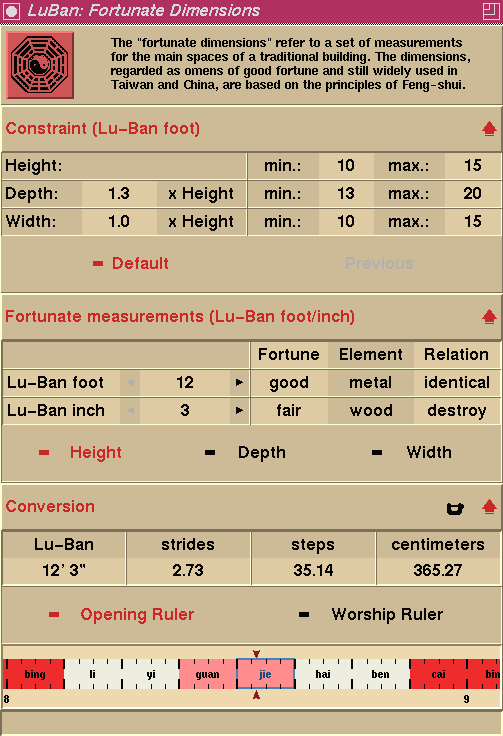
Chinese version of the interface for determining auspicious construction date
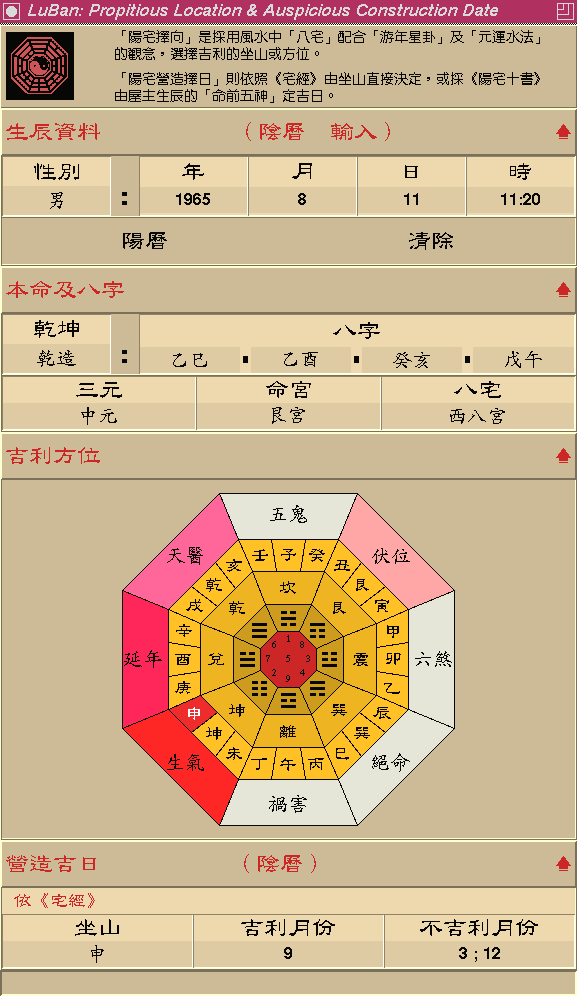
Related Publications
S-C Chiou and R Krishnamurti. Unraveling Feng-shui. Environment and Planning B:Planning and Design, 1997, 24(4) 549-572 [reprint pdf file file 15.4 Mbytes]
S-C Chiou and R Krishnamurti. The fortunate dimensions of Taiwanese traditional architecture. Environment and Planning B:Planning and Design, 1995, 22, 547-562 [reprint pdf file 10.3 Mbytes]
Shang-chia Chiou. Computational Considerations of Historical Architectural Analysis: A Case Study of Chinese Traditional Architecture, Ph.D Thesis, Architecture, Carnegie Mellon University, Pittsburgh, September 1996 [draft version pdf file 6.1 Mbytes]
© ramesh krishnamurti and chiou, shang-chia. 1997